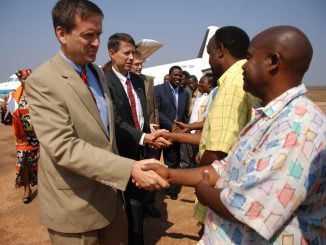MORRISVILLE, N.C. After a doctor’s visit, Nancy Lenfestey’s and Liz Ferm’s lives were changed. Before, their stresses consisted of what after school activity to attend or what household appliance to buy, but those small worries were suspended the moment they were told their sons had cancer.
Scott Lenfestey was diagnosed in November 2011 with acute lymphoblastic leukemia. He was 3. Alex Ferm, 8, was diagnosed in July 2013 with non-Hodgkin’s lymphoma. Both immediately began receiving treatment at UNC Children’s Hospital in Chapel Hill.
“Life for us stopped instantly,” Lenfestey said. “And everything that was important, and everything that was a priority in our life just kind of fell away. The day before Scott was diagnosed, our biggest dilemma was do we go to the PTA magic show later this week or do we go to martial arts.”
Ferm echoed Lenfestey.
“Life was like a sledgehammer,” she said. “It just stopped. We were shopping for dishwashers, and I was so stressed out. Which one will I get? It’ll be 10 more years. I was like, ‘Really, I stressed out about that? The little things?'”
Cancer is the leading cause of death by disease among children in the United States. About 15,000 children were diagnosed with cancer in 2014, according to the National Cancer Institute.
Dr. Dan Wechsler, the chief of pediatric hematology-oncology at Duke University Medical Center, said although the number of people diagnosed with cancer as a child is low, there is still an urgency in research to find cures.
“Pediatric cancer is pretty uncommon in the scheme of things,” Wechsler said. “There are 12,000 to 13,000 cases of pediatric cancer compared to 1.5 billion total cases of cancer, so it represents 1 percent of all cancers. But the issue is when a kid gets cancer and they cure them of cancer, they have their whole life ahead of them as opposed to someone in their 80s who gets cancer.”
Recognizing September as Childhood Cancer Awareness Month shines a light on the fact only 4 percent federal funding for cancer research goes toward childhood cancers.
Organizations like St. Baldrick’s Foundation have brought childhood cancer research to the forefront. Wechsler is a St. Baldrick’s grant recipient and has shaved his head multiple times at the nonprofit’s annual events.
St. Baldrick’s also was a support network for Lenfestey when she was struggling with the idea of Scott losing his hair.
“It was emotional for me,” she said. “It felt premature to me. I wasn’t ready to see that. We went there that day and he was so happy shaving it off. It turned things around for me, because I felt that cancer robbed us of so much at that point. Life stopped. I stopped working. The kids. Everything was disrupted. I was going to let it dictate when he’s going to lose his hair, too. [Instead I] let him do it.”
With research findings throughout the years, 80 percent of children stricken with cancer are now cured, but Dr. Wechsler said he doesn’t concentrate on percentages with patients.
“The thing with percentages are it’s fine if you have 100 kids, but if you have one kid, that kid is going to make it or is not going to make it, so we don’t spend a lot of time talking about percentages with families,” Wechsler said. “Our goal is to cure everybody.”
Wechsler added that he is always reminded that no matter what phase of treatment they are in, they are still kids.
“When people see kids who have lost their hair, they’re still kids, and they want to play and they want to be active, and they want to be treated like everybody else,” he said.
Ferm said she realized one day her son was still a kid and was still happy throughout treatment, and it helped change her attitude.
“It dawned on me at clinic one day that we are so worried and the kids just want to be kids,” Ferm said. “Of course, it is hard to. They are more resilient, so that’s what inspired me, because I’m like, ‘He is so happy and joyful, how can I be sad?'”
Lenfestey said Scott’s outlook throughout treatment helped her stay strong. She recounted a time he was receiving a part of chemotherapy that is referred to as “the red devil.”
“During this really intense phase, Scott had this chemo that is red,” she said. “It turns your urine red. There are some kids that when their tears come out their tears were red. I was like, ‘Oh gosh, this is so hard to watch it come.’ And Scott is like, ‘It’s fruit punch.’ And I’m like, OK. And then a bright yellow one came and he said now ‘it’s lemonade.’ I was like, ‘That is not what I would be thinking. Thank goodness that’s your mentally.'”
Ferm said one of the difficult parts of cancer treatment was Alex watching his friends in the hospital die and wondering if he was going to as well.
“You wouldn’t want any of your kids to have gone through this, Ferm said. “They’ve seen death. The biggest thing that I wouldn’t have wanted them to see, they have.”
Even though it is often a traumatic time for these children and their families, Dr. Wechsler notes the joy he finds in working with kids.
“A lot of times people say it is so depressing dealing with kids with cancer and sometimes it is,” Wechsler said. “But the majority of the time it isn’t, even when their outcome isn’t good, you’re still helping them in an incredibly difficult time.”



